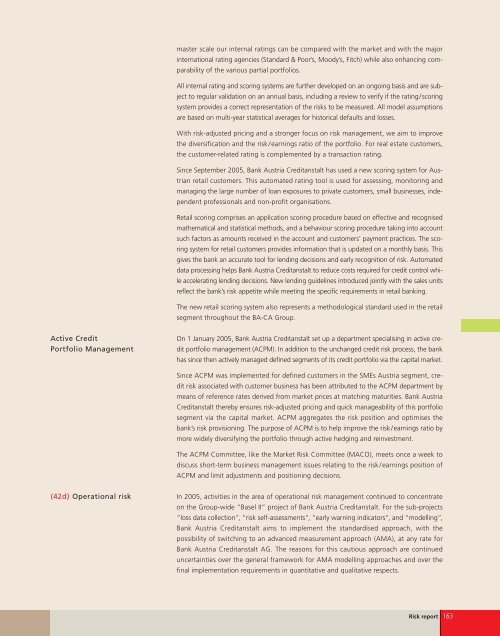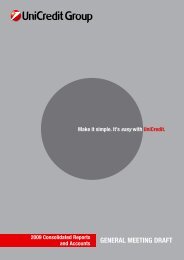team spirit - Bankier.pl
team spirit - Bankier.pl
team spirit - Bankier.pl
Create successful ePaper yourself
Turn your PDF publications into a flip-book with our unique Google optimized e-Paper software.
Active Credit<br />
Portfolio Management<br />
(42d) Operational risk<br />
master scale our internal ratings can be compared with the market and with the major<br />
international rating agencies (Standard & Poor’s, Moody’s, Fitch) while also enhancing comparability<br />
of the various partial portfolios.<br />
All internal rating and scoring systems are further developed on an ongoing basis and are subject<br />
to regular validation on an annual basis, including a review to verify if the rating/scoring<br />
system provides a correct representation of the risks to be measured. All model assumptions<br />
are based on multi-year statistical averages for historical defaults and losses.<br />
With risk-adjusted pricing and a stronger focus on risk management, we aim to improve<br />
the diversification and the risk/earnings ratio of the portfolio. For real estate customers,<br />
the customer-related rating is com<strong>pl</strong>emented by a transaction rating.<br />
Since September 2005, Bank Austria Creditanstalt has used a new scoring system for Austrian<br />
retail customers. This automated rating tool is used for assessing, monitoring and<br />
managing the large number of loan exposures to private customers, small businesses, independent<br />
professionals and non-profit organisations.<br />
Retail scoring comprises an ap<strong>pl</strong>ication scoring procedure based on effective and recognised<br />
mathematical and statistical methods, and a behaviour scoring procedure taking into account<br />
such factors as amounts received in the account and customers’ payment practices. The scoring<br />
system for retail customers provides information that is updated on a monthly basis. This<br />
gives the bank an accurate tool for lending decisions and early recognition of risk. Automated<br />
data processing helps Bank Austria Creditanstalt to reduce costs required for credit control while<br />
accelerating lending decisions. New lending guidelines introduced jointly with the sales units<br />
reflect the bank’s risk appetite while meeting the specific requirements in retail banking.<br />
The new retail scoring system also represents a methodological standard used in the retail<br />
segment throughout the BA-CA Group.<br />
On 1 January 2005, Bank Austria Creditanstalt set up a department specialising in active credit<br />
portfolio management (ACPM). In addition to the unchanged credit risk process, the bank<br />
has since then actively managed defined segments of its credit portfolio via the capital market.<br />
Since ACPM was im<strong>pl</strong>emented for defined customers in the SMEs Austria segment, credit<br />
risk associated with customer business has been attributed to the ACPM department by<br />
means of reference rates derived from market prices at matching maturities. Bank Austria<br />
Creditanstalt thereby ensures risk-adjusted pricing and quick manageability of this portfolio<br />
segment via the capital market. ACPM aggregates the risk position and optimises the<br />
bank’s risk provisioning. The purpose of ACPM is to help improve the risk/earnings ratio by<br />
more widely diversifying the portfolio through active hedging and reinvestment.<br />
The ACPM Committee, like the Market Risk Committee (MACO), meets once a week to<br />
discuss short-term business management issues relating to the risk/earnings position of<br />
ACPM and limit adjustments and positioning decisions.<br />
In 2005, activities in the area of operational risk management continued to concentrate<br />
on the Group-wide “Basel II” project of Bank Austria Creditanstalt. For the sub-projects<br />
“loss data collection”, “risk self-assessments”, “early warning indicators”, and “modelling”,<br />
Bank Austria Creditanstalt aims to im<strong>pl</strong>ement the standardised approach, with the<br />
possibility of switching to an advanced measurement approach (AMA), at any rate for<br />
Bank Austria Creditanstalt AG. The reasons for this cautious approach are continued<br />
uncertainties over the general framework for AMA modelling approaches and over the<br />
final im<strong>pl</strong>ementation requirements in quantitative and qualitative respects.<br />
Risk report 163
















